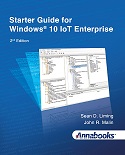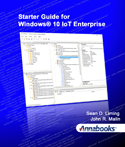Windows 10 IoT Enterprise: Unified Write
Filter and Boot Time Architecture Trade-Offs -
January 2024
A couple of developers noticed
that the latest Windows 10 IoT Enterprise release
is booting up slower than the older releases.
Their investigation also noticed a boot time
difference when UWF was enabled versus a clean
install of Windows 10 IoT Enterprise LTSC without
UWF. Since there has been more than one report on
the same issue, a little investigation was needed.
This paper goes over the boot time results for
several Windows 10 releases with and without UWF
enabled, and discusses the issue why UWF has an
effect on boot time.
|

|
Starter Guide for Windows 10 IoT
Enterprise 2nd Edition, Addendum 1 - December 2023
The addendum looks at the new improvements for
adding Windows updates and shrinking the image size. |

|
|
UP Square (UP2) Board Firmware Settings
to Enable SPI/I2C/GPIO/UART for Windows 10 IoT
Enterprise - January 2021
Article discusses the BIOS settings to setup the
UP2 Board’s 40-pin HAT connector for GPIO, SPI,
I2C, and UART for use with Windows Apps.
|
 |
| |
|
|
UP Board Firmware Settings to Enable
SPI/I2C/GPIO/UART for Windows 10 IoT Enterprise
- December 2020
Article discusses the BIOS settings to setup the
UP Board’s 40-pin HAT connector for GPIO, SPI,
I2C, and UART for use with Windows Apps.
|
 |
| |
|
|
Windows ADK: Checking Run-Time License
Key Activations with the Volume Activation
Management Tool - November 2020
Windows Activation can be challenge for an
Embedded/IoT devices. No one wants to see the
activate now water mark appear on a fielded
system. What can really be a trap is the limited
number of activation per license key and how
quickly the number goes down if you are not
careful. The article discusses the Volume
Activation Management Tool (VAMT) that can help
monitor the remaining activations.
|
 |
| |
|
|
Windows 10 IoT Enterprise: The Case of
the Magical Disappearing Utilities -
October 2020
Just when you think you have seen everything,
something new happens like utilities disappearing
from c:\Windows\System32.
|
 |
| |
|
|
Windows 10 IoT Enterprise: Image
Development Workflow - September 2020
A sound design process leads to a successful
project. This paper looks at the Annabooks’
workflow for developing Windows 10 IoT Enterprise
images. Developed over the last 20 years starting
with Windows NT Embedded, the workflow provides a
foundation to create a custom image and prepare
the image for production.
|
 |
| |
|
|
Windows 10 IoT Enterprise: Why No
Components Like Previous Windows Embedded
Releases? - February 2020
The size of the OS image is an important factor
in design. The size can impact disk space and RAM
requirements, which can impact costs. Also, if a
CRC check on bootup is needed, the smaller the
image the better. Gone are the days of Windows
Embedded where one could select the features put
into an image. Developers get the whole Windwos 10
IoT Enterprise footprint whether features are used
or not. This article looks at the history that has
led to this point, and some ideas to reduce foot
with what we have today.
|
 |
| |
|
|
Windows 10 IoT Enterprise (17763): Block
Device Installation - September 2019
Windows comes with many security and lockdown
features that we have covered in detail in various
books and articles. The one area that we have not
covered is block removable devices connecting to a
system. This article covers 2 solution to block
devices from connected to an embedded/IoT system.
|
 |
| |
|
|
How to Get Started with Windows 10 IoT
Licensing - August 2019
Building images have been covered in books and
articles, but when it is time to ship, you company
needs to be signed up for license Windows IoT.
Finding a distributor and signing the CLA is only
the first step as there are other websites to sign
up for and image development steps to follow.
|
 |
| |
|
|
DISM + FFU Capture and Restore an Image -
February 2019
In the past, OEMs had to use 3rd party tools to
capture disk images. With the release of Windows
10 Build 1809, version 17763, a new solution to
capture .FFU files using DISM is now available.
This article walks through the steps to perform a
disk capture and restore using DISM and .FFU
files.
|
 |
| |
|
|
Windows® 10 Enterprise LTSC 2019 – First
Look for Device Manufacturers - October 2018
Microsoft has released the new long-term service
version of Windows 10. The article takes a first
look at the changes to consider to migrate from
version 14393 to version 17763.
|
 |
| |
|
|
Windows® 10 IoT Enterprise: Multi-Project
/ Multi-Platform Support in SIM - July 2018
Article looks at a solution for supporting
multiple projects under the $OEM$ Folders in a
System Image Manager Distribution Share.
|
 |
| |
|
|
Windows 10 IoT Enterprise (14393): Turn
Off Windows Update and Managing Updates - May
2018
Controlling how a system gets updated is an
important part of the product life cycle. Poor
planning can hit the bottom line. Article looks a
solution to turn off Windows Update and how to get
the operating system update files to manually
update a system in the field.
|
 |
| |
|
|
Embedded/IoT OEMs and Windows as a Service
(WaaS) Rev 1.2 - January 2019
Some clients have asked about
using the Windows 10 Enterprise non-LTSB releases.
Article looks at the changes to the servicing and
discusses why Embedded/IoT OEM device
manufacturers should continue to stick with
Windows 10 Enterprise LTSB / LTSC.
|
 |
| |
|
|
Starter Guide for Windows® System Image
Manager: Addendum 1: Windows 10 IoT Enterprise
Build 10240 - November 2015
The book addendum covers Windows 10 IoT
Enterprise and the changes from Windows Embedded
8.1 Industry. The addendum covers the product
naming, changes to activation, new tools coming,
changes to the Lockdown Features, code examples
for customizing programmatic management of the
Lockdown Features.
|
 |
|
Running out of RAM and Disk Resources for
Windows Embedded Updates - August 2015
By Sean Liming / Edited by John Malin - As more
and more updates are available for WES7 and WE8S,
developers are noticing OS installation crashes
because memory and/or disk space is being
completely consumed. The article shows the issue
in action and some workaround solutions to get the
latest updates into an image.
|
 |
|
Windows 10 IoT – The Big Reboot - July
2015
By Sean Liming and John R. Malin - Introduction
to Windows 10 IoT and a transition roadmap from
previous Windows Embedded editions.
|
 |
|
Clonezilla Basics for Windows Embedded
- August 2014 : Update
September 2015
By Sean Liming and John R. Malin - Step-by-step
processes for using Clonezilla to capture and
deploy a master image that has been sysprep'd.
|
 |
|
Updates from Microsoft
Here are two updates for Windows Embedded 8.1
Industry’s Lockdown features:
KB2932074
– Fix for Windows 8.1 Application Launcher
KB2932354
– Embedded Lockdown Manager update for WEI 8.1 -
Adds support for Lockdown features not previous
supported through ELM.
|
|
|
Custom Power Settings for WES 7/8 and WEI
8.x - May 2014
By Sean Liming and John R. Malin - A method to
implement custom power systems in ICE and SIM
|
 |
|
WES 7/8 and Windows Embedded 8.x Industry
Device Driver Integration Techniques - May 2014
By Sean Liming and John R. Malin - A couple of
techniques to assist with driver integration. The
first is a trick to pull down the drivers using
Windows Update. The second discusses the impact
multiple INF have on the size of the image.
|
 |
|
Enabling Windows Server Roles in System
Image Manager
A follow-on article to the book Starter
Guide for Windows® System Image Manager
that covers how to enable server roles in System
Image Manager
|
 |
|
Can Motion Control Save Windows 8?
- June 2013
A though provoking article that
looks beyond the touch, keyboard, and mouse inputs
that have been around for some time. Windows 8 new
shell interface opens up the possibilities to use
other input devices to interact with the system,
and some of these devices are very close to
reality.
|
 |
|
The Windows Embedded Legacy Continues
with Windows Embedded 8 Standard - April 2013
Introduction to Windows Embedded 8 Standard
published in RTC Magazine
|
 |
|
Making PowerShell the Shell to the WES 7
System - September 2012
Simple steps to make PowerShell the main shell of
the system
|
 |
|
Pre-Adding TrueType Fonts to WES7 Image
- May 2011
Discusses how to add custom fonts to a WES7 image
using ICE.
|
 |
|
Introduction to Windows Embedded Standard
7 - May 2010
A first brief look at the new embedded OS.
|
 |
|
Installing FireFox Browser on WES7
- April 2010
Article looks at how to add FireFox Browser via
Image Configuration Editor (ICE)
|
 |
|
Installing Java on WES7 - April
2010
Article looks at how to add Java via Image
Configuration Editor (ICE)
|
 |


















